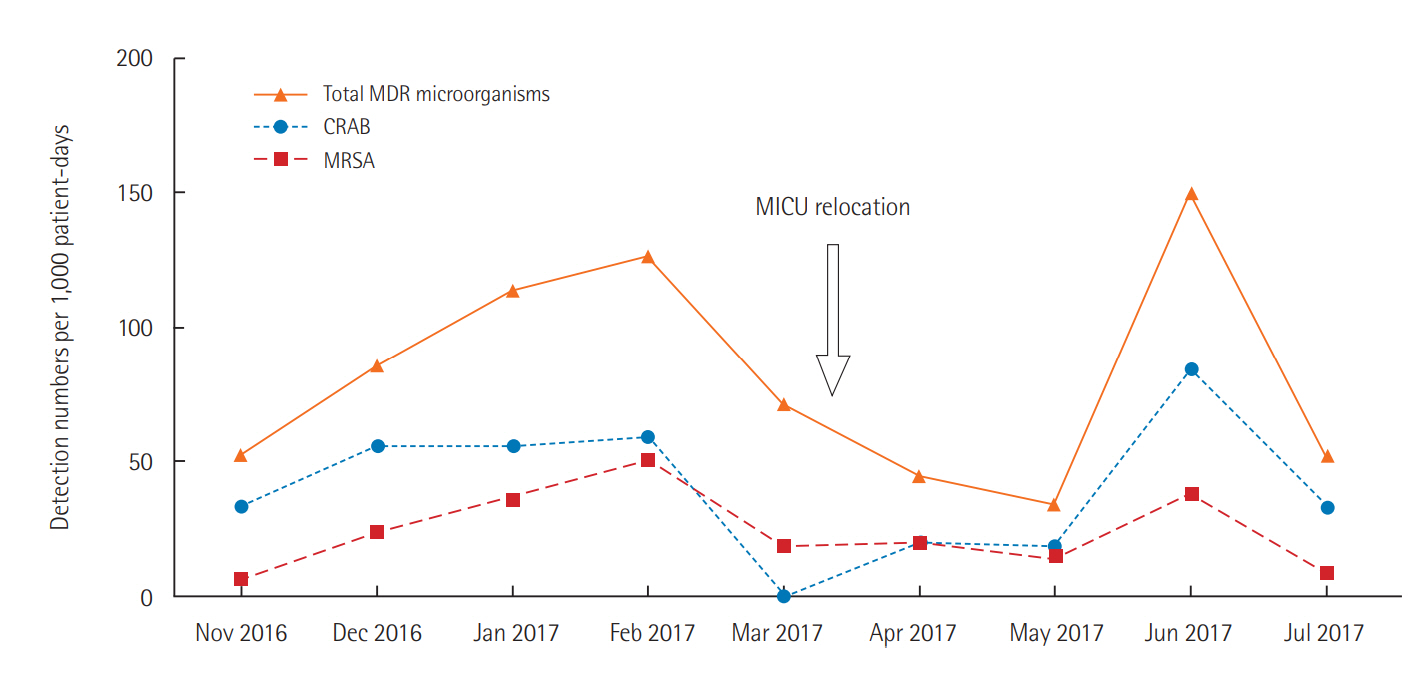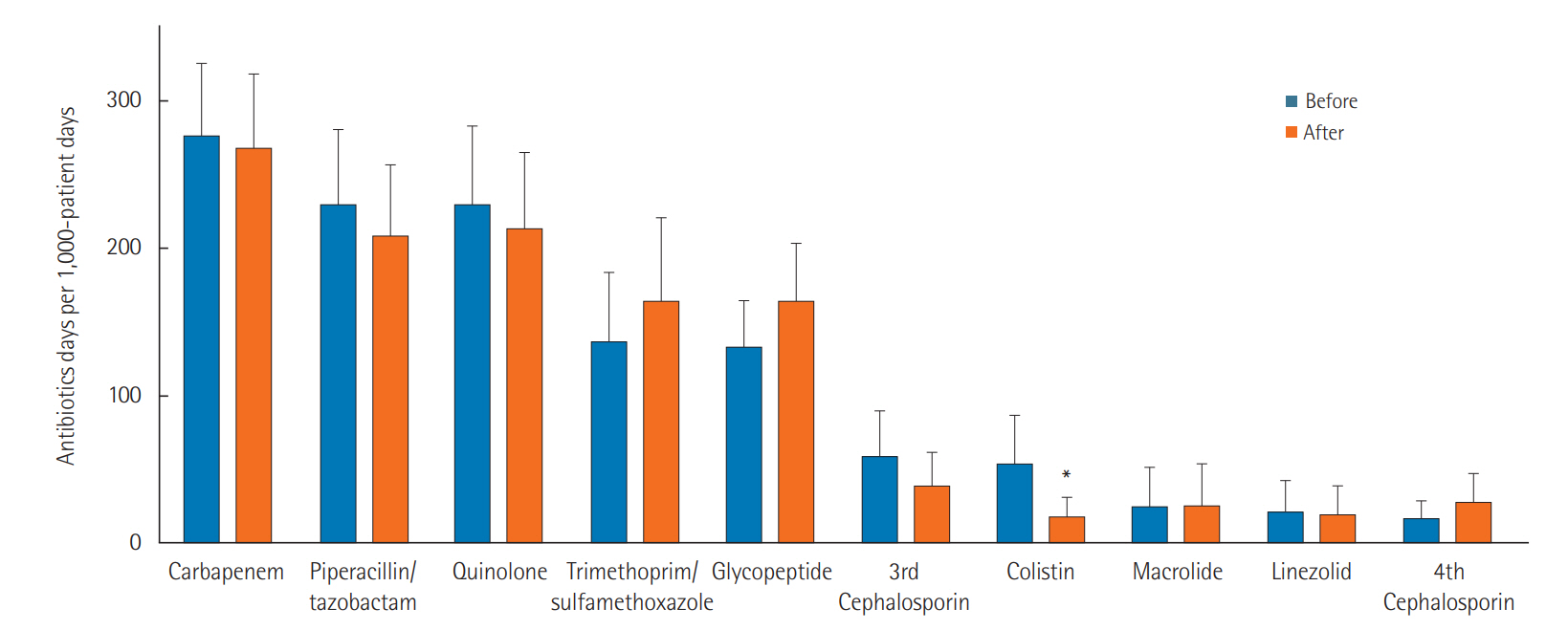Acute Crit Care.
2018 Nov;33(4):238-245. 10.4266/acc.2018.00220.
Intensive Care Unit Relocation and Its Effect on Multidrug-Resistant Respiratory Microorganisms
- Affiliations
-
- 1Division of Pulmonary and Critical Care Medicine, Department of Internal Medicine, Seoul National University Hospital, Seoul, Korea. realrain7@gmail.com
- 2Infection Control Center, Seoul National University Hospital, Seoul, Korea.
- KMID: 2441241
- DOI: http://doi.org/10.4266/acc.2018.00220
Abstract
- BACKGROUND
Infection by multidrug-resistant (MDR) pathogens leads to poor patient outcomes in intensive care units (ICUs). Contact precautions are necessary to reduce the transmission of MDR pathogens. However, the importance of the surrounding environment is not well known. We studied the effects of ICU relocation on MDR respiratory pathogen detection rates and patient outcomes.
METHODS
Patients admitted to the ICU before and after the relocation were retrospectively analyzed. Baseline patient characteristics, types of respiratory pathogens detected, antibiotics used, and patient outcomes were measured.
RESULTS
A total of 463 adult patients admitted to the ICU, 4 months before and after the relocation, were included. Of them, 234 were admitted to the ICU before the relocation and 229 afterward. Baseline characteristics, including age, sex, and underlying comorbidities, did not differ between the two groups. After the relocation, the incidence rate of MDR respiratory pathogen detection decreased from 90.0 to 68.8 cases per 1,000 patient-days, but that difference was statistically insignificant. The use of colistin was significantly reduced from 53.5 days (95% confidence interval [CI], 20.3 to 86.7 days) to 18.7 days (95% CI, 5.6 to 31.7 days). Furthermore, the duration of hospital stay was significantly reduced from a median of 29 days (interquartile range [IQR], 14 to 50 days) to 21 days (IQR, 11 to 39 days).
CONCLUSIONS
Incidence rates of MDR respiratory pathogen detection were not significantly different before and after ICU relocation. However, ICU relocation could be helpful in reducing the use of antibiotics against MDR pathogens and improving patient outcomes.
MeSH Terms
Figure
Reference
-
1. Magill SS, Edwards JR, Beldavs ZG, Dumyati G, Janelle SJ, Kainer MA, et al. Prevalence of antimicrobial use in US acute care hospitals, May-September 2011. JAMA. 2014; 312:1438–46.
Article2. Chung DR, Song JH, Kim SH, Thamlikitkul V, Huang SG, Wang H, et al. High prevalence of multidrug-resistant nonfermenters in hospital-acquired pneumonia in Asia. Am J Respir Crit Care Med. 2011; 184:1409–17.
Article3. Corrado RE, Lee D, Lucero DE, Varma JK, Vora NM. Burden of adult community-acquired, health-care-associated, hospital-acquired, and ventilator-associated pneumonia: New York city, 2010 to 2014. Chest. 2017; 152:930–42.4. Martin-Loeches I, Torres A, Rinaudo M, Terraneo S, de Rosa F, Ramirez P, et al. Resistance patterns and outcomes in intensive care unit (ICU)-acquired pneumonia: validation of European Centre for Disease Prevention and Control (ECDC) and the Centers for Disease Control and Prevention (CDC) classification of multidrug resistant organisms. J Infect. 2015; 70:213–22.
Article5. Santos RP, Mayo TW, Siegel JD. Healthcare epidemiology: active surveillance cultures and contact precautions for control of multidrug-resistant organisms: ethical considerations. Clin Infect Dis. 2008; 47:110–6.
Article6. Siegel JD, Rhinehart E, Jackson M, Chiarello L, Healthcare Infection Control Practices Advisory Committee. Management of multidrug-resistant organisms in health care settings, 2006. Am J Infect Control. 2007; 35(10 Suppl 2):S165–93.
Article7. Urban C, Segal-Maurer S, Rahal JJ. Considerations in control and treatment of nosocomial infections due to multidrug-resistant Acinetobacter baumannii. Clin Infect Dis. 2003; 36:1268–74.8. Aliberti S, Cilloniz C, Chalmers JD, Zanaboni AM, Cosentini R, Tarsia P, et al. Multidrug-resistant pathogens in hospitalised patients coming from the community with pneumonia: a European perspective. Thorax. 2013; 68:997–9.9. Falcone M, Russo A, Giannella M, Cangemi R, Scarpellini MG, Bertazzoni G, et al. Individualizing risk of multidrug-resistant pathogens in community-onset pneumonia. PLoS One. 2015; 10:e0119528.
Article10. An JH, Kim YH, Moon JE, Jeong JH, Kim SH, Kang SJ, et al. Active surveillance for carbapenem-resistant Acinetobacter baumannii in a medical intensive care unit: can it predict and reduce subsequent infections and the use of colistin? Am J Infect Control. 2017; 45:667–72.
Article11. Yap FH, Gomersall CD, Fung KS, Ho PL, Ho OM, Lam PK, et al. Increase in methicillin-resistant Staphylococcus aureus acquisition rate and change in pathogen pattern associated with an outbreak of severe acute respiratory syndrome. Clin Infect Dis. 2004; 39:511–6.
Article12. Teltsch DY, Hanley J, Loo V, Goldberg P, Gursahaney A, Buckeridge DL. Infection acquisition following intensive care unit room privatization. Arch Intern Med. 2011; 171:32–8.
Article13. Thomas Z, Bandali F, Sankaranarayanan J, Reardon T, Olsen KM; Critical Care Pharmacotherapy Trials Network. A multicenter evaluation of prolonged empiric antibiotic therapy in adult ICUs in the United States. Crit Care Med. 2015; 43:2527–34.
Article14. Huang H, Chen B, Liu G, Ran J, Lian X, Huang X, et al. A multicenter study on the risk factors of infection caused by multidrug resistant Acinetobacter baumannii. BMC Infect Dis. 2018; 18:11.
Article15. Nseir S, Blazejewski C, Lubret R, Wallet F, Courcol R, Durocher A. Risk of acquiring multidrug-resistant Gram-negative bacilli from prior room occupants in the intensive care unit. Clin Microbiol Infect. 2011; 17:1201–8.
Article16. Morgan DJ, Rogawski E, Thom KA, Johnson JK, Perencevich EN, Shardell M, et al. Transfer of multidrug-resistant bacteria to healthcare workers’ gloves and gowns after patient contact increases with environmental contamination. Crit Care Med. 2012; 40:1045–51.
Article17. Russotto V, Cortegiani A, Fasciana T, Iozzo P, Raineri SM, Gregoretti C, et al. What healthcare workers should know about environmental bacterial contamination in the intensive care unit. Biomed Res Int. 2017; 2017:6905450.
Article18. Gaynes R, Edwards JR; National Nosocomial Infections Surveillance System. Overview of nosocomial infections caused by gram-negative bacilli. Clin Infect Dis. 2005; 41:848–54.19. Eberle BM, Schnüriger B, Putty B, Barmparas G, Kobayashi L, Inaba K, et al. The impact of Acinetobacter baumannii infections on outcome in trauma patients: a matched cohort study. Crit Care Med. 2010; 38:2133–8.
Article20. Sunenshine RH, Wright MO, Maragakis LL, Harris AD, Song X, Hebden J, et al. Multidrug-resistant Acinetobacter infection mortality rate and length of hospitalization. Emerg Infect Dis. 2007; 13:97–103.21. Ibrahim EH, Sherman G, Ward S, Fraser VJ, Kollef MH. The influence of inadequate antimicrobial treatment of bloodstream infections on patient outcomes in the ICU setting. Chest. 2000; 118:146–55.
Article22. Abraham K, Dolman HS, Zimmerman LH, Faris J, Edelman DA, Baylor A, et al. Impact of inappropriate initial antibiotics in critically ill surgical patients with bacteremia. Am J Surg. 2016; 211:593–8.
Article23. Wisplinghoff H, Edmond MB, Pfaller MA, Jones RN, Wenzel RP, Seifert H. Nosocomial bloodstream infections caused by Acinetobacter species in United States hospitals: clinical features, molecular epidemiology, and antimicrobial susceptibility. Clin Infect Dis. 2000; 31:690–7.
Article24. Abbo A, Carmeli Y, Navon-Venezia S, Siegman-Igra Y, Schwaber MJ. Impact of multi-drug-resistant Acinetobacter baumannii on clinical outcomes. Eur J Clin Microbiol Infect Dis. 2007; 26:793–800.
Article25. Geisinger E, Isberg RR. Interplay between antibiotic resistance and virulence during disease promoted by multidrug-resistant bacteria. J Infect Dis. 2017; 215(suppl_1):S9–17.
Article26. Myers L, Mikhael B, Currier P, Berg K, Jena A, Donnino M, et al. The association between physician turnover (the “July Effect”) and survival after in-hospital cardiac arrest. Resuscitation. 2017; 114:133–40.
Article
- Full Text Links
- Actions
-
Cited
- CITED
-
- Close
- Share
- Similar articles
-
- Concept Analysis of Relocation Stress: Focusing on Patients Transferred from Intensive Care Unit to General Ward
- Multidrug-resistant Acinetobacter baumannii infection in the intensive care unit
- Path Analysis of Performance of Multidrug-Resistant Organisms Management Guidelines among Intensive Care Unit Nurses : With Focus on the Theory of Planned Behavior and Patient Safety Culture
- Factors Influencing Relocation Stress Syndrome in Patients Following Transfer from Intensive Care Units
- Role of Microbiologic Culture Results of Specimens Prior to Onset of Ventilator-Associated Pneumonia in the Patients Admitted to Intensive Care Unit




